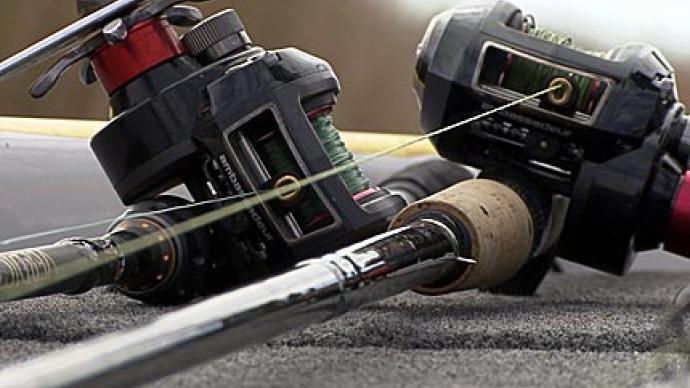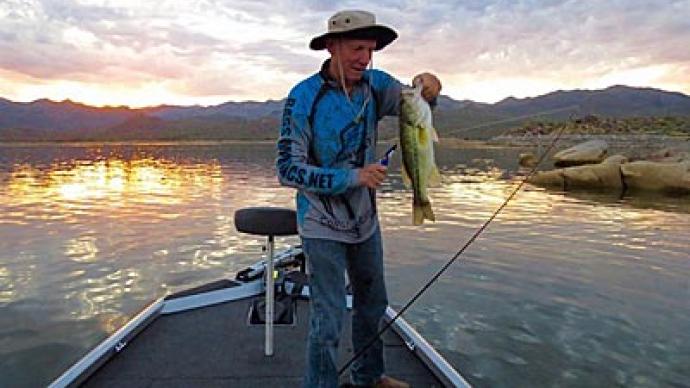
With all the line options available for today's fisherman, it may surprise you that during my younger years fishing the bass tournament circuit, I exclusively used one line – Trilene XT. There were some infrequent occasions in the spring of the year, (tossing real light, tight wiggling crankbaits) when I would switch to Trilene XL. Years later, I again turned to XL when I needed crankbaits to run down to depths of 20 feet.
The beginning angler must recognize that most of my success resulted from just those two lines: Trilene XT and XL. Truthfully, I could have used XT exclusively - I would have simply dropped down to a smaller pound test until I found the line diameter I needed.
Keep that in mind as we talk about selecting the "best" line for the following techniques and baits: Spinnerbaits, Crankbaits, Topwaters, Texas Rigs, Carolina Rigs, Drop-shotting, Pitching, Flipping, Blade Baits and Spoons.
Any angler longing to perfect these techniques and lures will discover some subtle but essential advantages to understanding all the pros and cons of today's vast choices in fishing line.
Most modern lines fall into three basic categories: monofilaments, superlines/braids, and fluorocarbons. Each group has unique characteristics concerning strength, stretch, and visibility. So, let's go down through my favorite baits and discuss the best line to select for that bait and why.
Spinnerbaits
When throwing a spinnerbait, the choice is simple; in almost all circumstances, I use a monofilament line. I prefer a tough line like Trilene XT.
While monofilament is my choice for 90% of my spinnerbait fishing, there is one exception: fishing in heavy aquatic vegetation. When running a spinnerbait over the top of hydrilla, milfoil, or throwing back into thick lily pads, I switch to a braided line or superline, like Spiderwire or Fireline.
The reason for using a braided line or superline is its amazing ability to cut through the aquatic vegetation. Mono will get wrapped up in the grass but not slice through it, often forcing me to get the fish. Too often, the fish will pull off when I get there.
However, if I am fishing spinnerbaits around open water, wood, boat docks, or any other structure other than grass or aquatic vegetation, my preferred line is monofilament.
Note: It is essential to point out that monofilament stretches, allowing a heavier rod to be used. But braided line or superline does not stretch. Therefore, when fishing a spinnerbait on these lines, it's essential to switch to a lighter rod. Fighting a big bass requires some "give" in the presentation to prevent fish from coming unbuttoned. A lighter rod makes up for the lack of line stretch by absorbing some of the shock, increasing my chances of fighting that big bass and getting it to the boat.
Let me also point out that setting the hook too early with a spinnerbait will lead to many missed fish. The natural stretch in monofilament gives an angler an advantage by providing a slight but significant delay in the hookset. To accomplish that same hesitation with braided or superline, I use a softer or lighter rod. It helps to create that little bit of pause during the hook set, so the point has time to dig in.
Crankbaits
If I am fishing crankbaits, I prefer fluorocarbon because it is neutral. By that, I mean it doesn't float and allows your baits to dive a little deeper. Line selection for crankbait fishing is simple - across the board, I'm going to fish with fluorocarbon.
Topwater
When fishing topwater baits, I prefer a line that floats. This is where monofilament has the advantage. And naturally, a bigger diameter line floats even more. I like to use a heavier line because it floats and makes my topwater baits perform correctly.
Texas Rig
Unlike topwater, a floating line creates problems when Texas Rigging. This is especially true when making long casts. A floating line creates an unwanted arch in the water, and all that slack makes it hard to get a solid hook set.
When throwing a Texas Rig, I prefer the neutral characteristics of fluorocarbon because it provides a direct link or straighter pathway through the water to my bait. Eliminating the slack helps produce a rock-solid hook set.
Carolina Rig
The reels I use for Carolina Rigging are filled with Fireline. A weight is slipped over the end of the Fireline, which is then tied directly to a swivel. From the swivel, a clear fluorocarbon leader is tied on that goes to the bait. The only exception to a fluorocarbon leader occurs when I want my bait to float slightly off the bottom. That's when a monofilament leader comes in handy.
Whether I use Fireline or Spiderwire Stealth, the sensitivity of these lines improves my ability to read the makeup of the bottom, detect structure, and discern a subtle bite. So keep it simple; use either a fluorocarbon or monofilament leader but Fireline or Spiderwire Stealth as your main line.
Drop-Shot
I prefer fluorocarbon when I am drop-shotting for two reasons: first, I have a slightly better sense of feel than monofilament. Most of the time, I am fishing light line in 12 to 30 feet or even deeper - so the increased sense of feel that fluorocarbon provides can sometimes be critical.
And secondly, I like to fish the drop-shot in clear water, and fluorocarbon is the clearest line on the market. I know of no transparent line that is smaller in diameter and clearer than fluorocarbon.
Flipping and Pitching
When I am flipping or pitching, I stick with monofilament, specifically Trilene XT or Big Game.
The exception comes when I am flipping and pitching into heavy aquatic vegetation. That's when I turn to Spiderwire Stealth because it cuts through that grass.
I also get a better hook-up with Spiderwire Stealth than with other lines. If I'm tossing a big 1-ounce Eco Pro Tungsten weight in an attempt to punch through heavy grass, monofilament will meet with a lot a of resistance. As a result, the pounds of pressure placed on the tip of the hook during a hard hook set is significantly reduced with monofilament.
Fluorocarbon is just a little too brittle for flipping into that heavy cover. Nor is it as good a shock absorber as monofilament. And, like monofilament, fluorocarbon doesn't cut through the grass.
So stick with monofilament unless you are in heavy vegetation. Then, the clear choice is a braided or superline. And there is nothing better, in my opinion, than Spiderwire Stealth. You can also use Fireline for flipping or pitching, (I like it, but it's just a little bit stiff for me). I prefer Spiderwire Stealth.
Blade Baits and Spoons
When fishing blade baits and spoons, I tend to be fishing deep water, primarily under the boat, and therefore, it's essential to have a transparent and sensitive line. When fishing a free-falling bait, you want the extra sensitivity, so I like fluorocarbon.
Final Thoughts
I genuinely believe that when a specific technique or lure is matched with the proper line, the ultimate and perfect combination can be attained that provides an angler with a slight edge. Having said that, I again want to stress that if all these combinations are not an option, rest assured, you can fish all those baits on a quality monofilament line like Triline XT.
For more articles, quick tips, and much more, visit HankParker.com.




